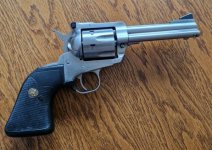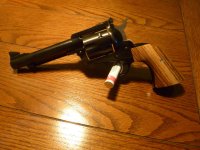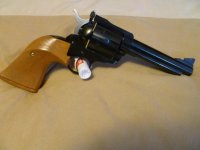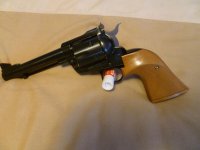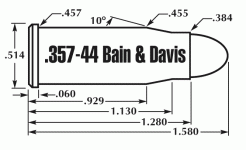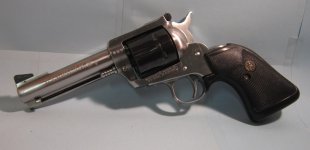Thanks, i'll get some measurements/refresh my memory and let you know what i think. I bought the blue New model back in the late 70's early 80's, then i saw a 9mm stainless cyl. on ebay (30 years later) and bought it on a "lets see if this will work" kind of approach. It fit! all chambers align w/bbl using gauge rod. started loading 9mm and found some were too long and i could not rotate the chamber as the case head interfered with the breach face lip on the frame. I thought it may have been the chamber depths. But after reading your posts it re-lit my interest. Both cylinders OAL measure 1.978 +/-.003".
After reading your post i checked the BCG's .357=.005.
9mm=.012 +.001/-.000.
So if i machined .008 off the small protruding front cyl. bushing.... math would say i would reduce my BCG to~.004" and increase the space behind the cyl. (between the rear face of cyl. to the frame breach face) by .008" which may be enough for the cases to index properly past the "breach face lip".
My concern, perhaps unfounded due to the linear forces when firing, and the (space filled with the case heads) is the "new" .008" gap at the rear between the index star and the frame.
Is there any end shake concerns? I think i was hesitant to shorten the cyl. length without fully knowing what i was doing.
Thanks for restarting my interest!
This approach would create an extreme excess endshake condition. At that point, the B/C gap measurement would be totally meaningless as it would be a variable from .004” to .012”, as the cylinder flopped around .008” back and forth.
If you were to try this this, a possible semi-fix would be to install an endshake shim between the cylinder rachet and the recoil shield. But, you may then have headspace issues.
This topic has been discussed often on the various Ruger related forums, as endshake conditions can be quite problematic in the Blackhawk, compared to something like the Colt SAA.
The consensus is that such a problem is best remedied by returning the gun to Ruger to have a new cylinder fitted.
Separately, this thread topic is kind of curious. While the .45 ACP/Long Colt convertibles have a certain practicality, retrospectively the 357/9mm convertible has been looked upon mostly with puzzlement or even scorn.
Writing in the 1970s, noted gun scribe Bob Milek reviewed both the .45 and .357 converibles and deemed the latter to be mostly useless. At that time, 9mm was not a particularly admired cartridge. It was also not cheap! And, besides the ballistic inferiority of the 9mm, at least in this application, the accuracy was consistently mediocre.
However, the .357/9mm convertible did have one saving grace, at least to some end users. The 9mm cylinder could be readily converted to other cartridges!! Perhaps the most popular and successful being the wildcat (figuratively and literally!) .357 Bain & Davis. This “blast from the past” was a bottleneck cartridge based on a necked down .44 Magnum case.
Yes, it’s a “handloaders only” proposition, but it really packs a punch!

